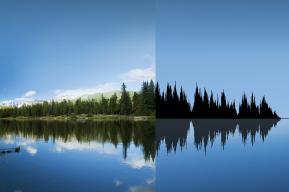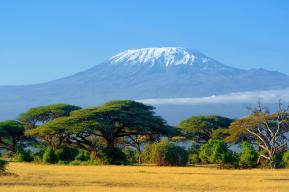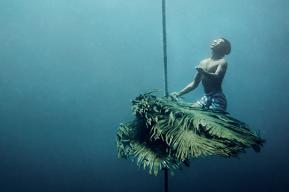مقال
الجزر، واجهة هشّة للتنوع البيولوجي

رغم أن الجزر لا تمثل سوى جزء صغيرٍ من مساحة الأرض، فهي موطنٌ لجزء كبير من التنوّع البيولوجي في العالم. لكن العديد من أنواع الجزر مهدّد اليوم بالانقراض بسبب الأجناس التي اجتاحتها رغما عن وجود إجراءات ممكنة للحفاظ على ثرائها الطبيعي الاستثنائي.
دينا ر. سباتز
كبيرة علماء الحفاظ بمنظمة المحافظة على ضفاف المحيط الهادئ، الولايات المتحدة
نيك د. هولمز
باحث في منظمة حفظ الطبيعة، الولايات المتحدة
لكلّ الجزر عُمُرٌ محدّد، وموقع جغرافي معيّن، ودرجة من العزلة تختلف من واحدة إلى أخرى. هذه الخصائص تجعل منها كيانات فريدة من نوعها تحتوي على أنظمة بيئيّة مكوّنة من تجمّعات من النّباتات والحيوانات لا مثيل لها في أيّ مكان آخر. فبعض الأجناس طوّرت سمات نادرة مثل العملقة (تضخّم الأجسام) أو القزامة أو فقدان الأجنحة (عدم القدرة على الطيران).
ورغم أن الجزر لا تمثّل سوى %5 من مساحة الأرض، فهي تضمّ حوالي %17 من أنواع الطيور والنبات في العالم. وتأوي بعض السواحل الاستوائية شعابا مرجانية تُعَدُّ من أكثر الأنظمة البيئية تنوّعًا بيولوجيًا في العالم، وتؤمّن عيش ملايين البشر. هذا، ويمكن أن تستوطن عديد الأجناس الجزيرية جزيرة واحدة أو أرخبيلا بأكمله.
تُعدّ مدغشقر، واحدة من أكبر الجزر في العالم وإحدى النقاط السّاخنة للتّنوّع البيولوجي العالمي، فهي تحتضن ما لا يقل عن 15.000 جنس محلي من النّبات الأرضي من بينها %85 جنسا مستوطنا، وفيها أكثر من 1.000 نوع من زهور الأوركيد. أما في جزر الهاواي، فقد تمكّن طائر قارّي صغير من التّأقلم مع حياة الجزيرة، وأنجب ما يُقارب عن نصف الطّيور البرية في هاواي. وتَعُدّ سُلالته، المعروفة بـالهونيكريبرز الهاوايي honeycreepers، أكثر من 50 نوع، لكلّ منها منقاره ولسانه الخاصين بحسب الموارد الغذائية التي يقتات منها من بذور وفواكه وحشرات ورحيق. وتعتبر هذه الطّيور شاهدا مميّزا على التطوّر في بيئة جزيرية.
طائر الدّودو، والسّلحفاة العملاقة، وخفّاش البيبسترال
منذ بداية القرن الخامس عشر، سجّلت الجزر أغلب عمليات انقراض الأجناس (%61) سواء نتيجة الصيد العشوائي، أو بفعل تدمير الموائل، أو جرّاء إدخال الحيوانات المفترسة. ونعلم المصير الذي لقيه طائر الدّودو الشّهير، وهو نوع من الحمام دون أجنحة، كان يعيش في جزيرة موريس قبل أن ينقرض تماما. ولم يكن وحده الذي عرف هذا المصير، فأكثر من عشرين جنسا من الأجناس الأصلية للجزرهجرت جزر ماسكارين الواقعة جنوب غربي المحيط الهندي -لا سيما السلحفاة ذات الحجم العملاق وطول العمر الاستثنائي- .
لكن الانقراض ليس ظاهرة تنتمي إلى الماضي فحسب. ففي كيريباتي، أعلن سنة 2012، عن انقراض بيبسترال جزيرة كيريتيماتي، وهو خفاش صغير جدّا، يزن أقل من 5 غرامات. فالإجراءات الكفيلة بإنقاذه جاءت متأخّرة جدّا. وقد رُصدت آخر صرخة له عام 2009.
ولقد أُجريت دراسة على ما يقارب 3.000 حيوان بين طيور، وثدييّات، وزواحف، وبرمائيات، "مهدّدة بشكل حرج بالانقراض" أو "مهدّدة بالانقراض" وفقًا لمعايير القائمة الحمراء للأجناس المهدّدة للاتحاد العالمي لحفظ الطبيعة UICN، وبيّنت هذه الدّراسة أنّ %41 من هذه الحيوانات في طور الانقراض تتكاثر في بيئة الجزر، وهو ما يدلّ على التّمركز المذهل للأجناس المهدّدة بالانقراض في هذا الجزء الصغير من كوكب الأرض.
ويعود السّبب الرئيسي للانقراض إلى الأجناس التي اجتاحت الجزر، سواء التي أُدخِلت منها عن قصد أو التي قَدِمت عَرَضًا، وكان لها عواقب وخيمة على الأجناس المحلّية بل على توازنات الأنظمة البيئية برمّتها. فمن المعلوم أن 30 جنسا من الأجناس المُجتاحة مسؤولة، لوحدها، عن انقراض 738 جنسا حيوانيا عبر العالم. كما أنّ لها دور في %86 من حالات الانقراض المعروفة في الجزر.
وتعتبر الثدييّات المُجتاحة مدمّرة على نحو خاصّ، فالحيوانات المفترسة، مثل القط البرّي والنّمس، تهاجم الأجناس المحلية، في حين أن الحيوانات العاشبة، مثل الماعز والخنزير، تُفسد المشهد الطبيعي وتساهم في هدم الموائل. فالأجناس الجزيرية غالبا ما تطوّرت عبر التاريخ في غياب حيوانات مفترسة أو حيوانات منافسة أو أخرى عاشبة، مما أدّى إلى تطوّر الطّيور الفاقدة للأجنحة أو النباتات الخالية من الأشواك، وعموما، إلى اكتساب هذه الحيوانات الجزيرية الأصلية صفات ساذجة جعلتها في حالة هشاشة أمام عدوانية الأجناس المُجتاحة.
في جزر غوف بالمحيط الأطلسي، وماريون بالمحيط الهندي، وميدواي بالمحيط الهادئ، تعلّم الفأر الرّمادي، وهو أصغر الثدييات المُجتاحة، مطاردة وقتل القُطرس، أكبر الطيور البحرية، ورغم ذلك تظلّ أنثى هذه الطّيور تلد صغارها وتقبع معها في عشّها غير مكترثة بهذا التّهديد رغم الهجمات المتكرّرة للفئران والقاتلة في أغلب الأحيان، لأنّها غير مدركة لهذا الخطر.
مقاومة الثدييّات المُجتاحة
إنّ الحلول لوقف انقراض بعض الأجناس متوفّرة بفضل تقنيات الحفظ. ففي نيوزيلندا، أعطت مراقبة الثدييات المُجتاحة، أو القضاء عليها الكامل، نتائجها. وفي جزيرة بالميرا المرجانية بجنوب المحيط الهادئ، أدّى القضاء على فئران المحيط الهادئ، وهي من الأجناس المُجتاحة التي تتغذى بالنباتات المحلّية الصغرى، إلى نموّ الغابات المحلية بنسبة %5.000.
مثال آخر: سمح استئصال الفئران من جزيرة صغيرة في عرض أنتيغوا من منطقة البحر الكاريبي بمضاعفة عدد الأفاعي المستوطنة (ألسوفيس أنتيجوا Alsophis antiguae) بمعدّل عشرين مرّة، وهي الأفاعي الأكثر ندرةً في العالم. وقد كشفت دراسة حديثة استعادة مئات الأجناس المحلية المهددة بالانقراض نتيجة القضاء على الثدييات المُجتاحة.
كما يمكن أن يكون التسييج حلّا فعّالا في هذا المجال، خاصة في الجزر الكبيرة المكتظّة، حيث أصبح علماء البيئة يُنشؤون "جزرًا داخل الجزر". ففي كاينا بوينت ستيت بارك بهاواي، سمح هذا الإجراء ببناء موائل آمنة وخالية من الحيوانات المُجتاحة المفترسة، حيث يمكن لطيور قطرس لايزان، والقطارس ذات السّيقان السوداء، أن تتكاثر وتنمو. وقد ساعد بثّ صرخات القطرس بواسطة أنظمة الصّوت، ونشر قطارس وهمية في وضع المغازلة، على استعادة هذه المجموعات إلى تلك المواقع.
تُعَدُّ كاينا بوينت واحدة من آخر الأنظمة البيئية الساحلية المتبقية في هاواي والمحمية ضدّ ارتفاع منسوب مياه البحر بسبب علوّها، لأن التغيّر المناخي يزيد، بدوره، في تفاقم الوضعية الحرجة التي تمرّ بها الأجناس المهدّدة. وفي واقع الأمر، فإن حسن إدارة الحيوانات المجتاحة في المواقع المرتفعة، ونقل الأجناس المهدّدة إلى هذه المواقع يساعدان على تحسين آفاق الإبقاء على التنوّع البيولوجي للجزيرة.
آخر الفضاءات البريّة
من بين الطّرق الأخرى للمساعدة على حماية الأجناس المهدّدة جمع البيانات المتعلّقة بالحفظ، فقاعدة البيانات حول التنوّع البيولوجي المهدّد في الجزر تبيّن، مثلا، كيفية توزّع الطّيور، والثدييّات، والزّواحف، والبرمائيّات المهدّدة بالانقراض والمعرّضة إلى المخاطر في جميع أنحاء العالم. فهذه الأجناس لم تعد موجودة سوى في 1.288 جزيرة تُمثل %0.3 من مساحة الجزر في العالم. هذه البيانات سوف تسمح لأخصّائيي البيئة بضبط إجراءات الحفظ القابلة للإنجاز، وترتيب أولوياتها. كما توفّر قاعدة البيانات الخاصّة باستئصال الأجناس الجزيرية المجتاحة تفاصيل عن طرق ونتائج مشاريع القضاء على الأجناس المُجتاحة المُنجزة في جزر العالم بأسره، وتتضمّن معلومات عن الإجراءات الرّامية إلى القضاء على 1.400 جنس من الأجناس المُجتاحة في 940 جزيرة مدرجة، حيث نجحت التجربة في %88 منها. هذه الأداة من شأنها المساعدة على تقييم النجاحات، والتخطيط لمشاريع جديدة، وتقييم التقدّم المحرز في تحقيق الأهداف المرسومة ضمن اتفاقية الأمم المتحدة للتنوّع البيولوجي.
وأخيرا، هناك أمر عاجل. فالموائل الجزيرية هي من بين آخر الفضاءات البرّية على وجه الأرض. وقد بيّنت التّجربة أنّ رصد مبلغ، ولو محدود، من أموال المحافظة لفائدة الجزر من شأنه أن يدرّ عوائد استثمار مرتفعة في مجال تعزيز استرداد الأجناس في طور الانقراض، وإعادة اكتشاف أجناس يُعتقد أنها انقرضت. ولعلّ مثل هذه النجاحات تبرز الفرص الحيوية التي تمنحها الجزر لكوكبنا في مجال المحافظة على التنوّع البيولوجي.
مطالعات ذات صلة
أرخبيل كولومبوس: السكّان يتجنّدون، رسالة اليونسكو، يوليو- سبتمبر 2018
مصالحة بين الإنسان والطّبيعة، رسالة اليونسكو، يوليو- سبتمبر 2018
جزر عالمية، عالم الجزر، الرسالة الجديدة، أبريل 2004
اشترك في رسالة اليونسكو لمتابعة الأحداث. الاشتراك في النسخة الرقمية مجاني %100.
By Dena R. Spatz and Nick D. Holmes
Islands all have distinct ages, geographical locations, and degrees of isolation. These characteristics make each island unique – allowing them to house ecosystems with concentrations of flora and fauna found nowhere else. Some of these species evolve rare traits – such as gigantism, dwarfism, and flightlessness.
Although islands account for just five per cent of the world's land-mass, they are home to approximately seventeen per cent of the world's bird and plant species. Some tropical coastlines are home to coral reefs that are among the most biologically diverse ecosystems in the world – sustaining the livelihoods of millions of people. Many island species are found only on one island or island group, and are thus considered endemic to that location.
Madagascar, one of the world's largest islands and recognized as a global biodiversity hot spot, is home to 15,000 native species of land plants – eighty-five per cent of which are endemic, including over 1,000 species of orchids. In the Hawaiian Islands, a small continental bird has adapted to island life and eventually gave rise to nearly half of all Hawaiian land-birds. Its descendants, the Hawaiian honeycreepers, have more than fifty species, each with a different bill and tongue shape that is specially adapted to different food sources – seeds, fruit, insects or nectar. These birds provide a remarkable narrative of evolution in an island environment.
Dodos, giant tortoises, and pipistrelles
Since the beginning of the fifteenth century, sixty-one per cent of the global loss of species to extinction has occurred on islands – due to poaching, habitat loss and predation from introduced species. We know the fate of the famous dodo, a kind of flightless pigeon from Mauritius, which has disappeared forever. But it is just one of nearly two dozen native island species lost from the Mascarene Islands in the south-west Indian Ocean – including the extraordinarily large and long-lived giant tortoise.
A staggering concentration of extinctions have occurred on islands
Yet, extinctions are not just a thing of the past. In Kiribati, the Kiritimati Island pipistrelle, a tiny bat weighing less than five grams, was declared extinct in 2012. Conservation measures taken to save it were too late – the bat’s last call was detected in 2009.
A study of nearly 3,000 birds, mammals, reptiles and amphibians – classified as endangered or critically endangered by the International Union for Conservation of Nature’s IUCN Red List of Threatened Species – found that forty-one per cent of these endangered animals breed on islands. This highlights the staggering concentration of species threatened with extinction on such a small area of the planet.
Invasive species are a major driver of extinctions. Whether they are deliberately or accidentally introduced to areas outside their natural range, they can adversely affect native species and entire ecosystems. Only thirty invasive species have been linked to the extinction of 738 animals worldwide. These losses were concentrated on islands, where the invasive species were implicated in eighty-six per cent of known extinctions.
Invasive species are a major driver of extinctions
Invasive mammals are particularly devastating – predators such as cats and mongooses prey upon native species, while herbivores, such as goats and pigs, alter landscapes and contribute to habitat loss. Island species often evolved in the absence of predation, competition, or herbivory. This resulted in the evolution of flightless birds or thornless plants, and an overall naive disposition of native island animals, which are especially vulnerable to these aggressive invasive species.
On Gough Island in the Atlantic, Marion Island in the Indian Ocean, and Midway Atoll in the Pacific, the grey-brown house mouse, the smallest invasive mammal, has learned to prey upon and kill the albatross, the largest of seabirds. Unaware of this threat, breeding adults and their chicks stay in their nests in spite of relentless, often fatal, attacks by the mice.
Fighting invasive mammals
There are ways to save certain species from extinction, using conservation techniques. In New Zealand, the control or complete eradication of invasive mammals has been successful. On Palmyra Atoll in the South Pacific, eradicating the Pacific rat, an invasive species which fed on native seedlings, resulted in a 5,000 per cent increase in native forest growth.
In another example, the eradication of rats from an islet off Antigua in the Caribbean led to a twenty-fold increase in the population of the endemic Alsophis antiguae, or Antiguan Racer, the world's rarest snake. A recent study found that hundreds of threatened native species rebounded following the eradication of invasive mammals.
Fences can also be effective to keep out invasive species – especially on large, populated islands where conservationists are now creating “islands within islands”. Building a fence at the Ka’ena Point State Park in Hawaii has created a safe and predator-free habitat for Laysan and Black-footed albatrosses to breed and thrive. The broadcasting of albatross calls using sound systems and deploying albatross decoys in courtship displays has boosted population recovery at these sites.
Due to its elevation, Ka’ena Point is one of the last remaining native coastal ecosystems in Hawaii that is safe from sea-level rise. Climate change is also exacerbating the plight of threatened island species. Yet, solutions such as managing invasive species on high elevation sites and moving threatened species to these sites when necessary, is improving the prospects for the survival of island biodiversity.
The last remaining wild spaces
Establishing conservation databases is another way to help endangered species. The Threatened Island Biodiversity Database (TIB), for example, documents the distributions of critically endangered and endangered birds, mammals, reptiles, and amphibians around the world. These species occur on just 1,288 islands, representing only 0.3 per cent of islands worldwide.
This data allows ecologists to identify and prioritize feasible conservation actions. The Database of Island Invasive Species Eradications (DIISE) documents the methods and outcomes of invasive species eradication projects on islands worldwide. It contains information on eradication efforts for 1,400 invasive species on 940 islands – eighty-eight per cent of which were successful. This tool can help conservation managers evaluate past successes, plan new projects, and measure progress towards targets set by the United Nations Convention on Biological Diversity.
There is a real urgency to protect unique island habitats, which represent the last remaining truly wild places on earth. Experience shows that allocating limited conservation funds to islands generates high returns – promoting the recovery of species on the verge of vanishing, and the rediscovery of species once thought to be extinct. These successes highlight the vital conservation opportunities that islands hold for our planet.
Dena R. Spatz
Senior Conservation Scientist at Pacific Rim Conservation, Hawaii.
Nick D. Holmes
Lead Scientist, Island Conservation Terrestrial at the Nature Conservancy, California.

In the same issue










